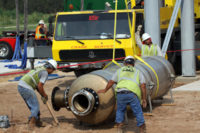

Energy efficiency "represents the most important plank in efforts to decarbonize the global energy system and achieve the world's climate objectives," said International Energy Agency officials in the body's second annual report on the energy- efficiency market, released in October.
One measure of energy efficiency (EE) is energy intensity, or the ratio of energy consumption to another metric, such as floor space for a building or units of production for a manufacturing plant. Efficient use of energy reduces energy intensity, which reduces the cost of energy per unit. That, essentially, is the goal of an EE program.
A Dept. of Energy program, the multi-tiered Better Buildings Initiative, is enlisting EE to help meet the nation's energy needs. In 2013, commercial and industrial buildings used roughly 50% of the energy in the U.S. economy, according to DOE officials. The Better Buildings Initiative supports action by energy users to make their buildings and operations much more efficient using a variety of cost-effective improvements, they say.
More than 200 organizations are partners in the program and represent diverse building sectors, including industrial plants and commercial, multifamily and public buildings. On Sept. 30, data centers were added to the mix, with 19 companies joining the program. These organizations have committed to improving efficiency in more than 3 billion sq ft of building stock across the country.
As a result of their investments in EE projects, program partners have saved 36 trillion Btus, or $300 million, since the beginning of the Better Buildings Challenge, a program that targets CEOs and executives, DOE officials say. Financial allies have successfully placed more than $1.7 billion in funding for EE projects by employing a range of innovative financial products, including equity reinvestment, distributed-generation contracts and tax-exempt leases.
Innovative Financing
A small plastics manufacturer in upstate New York uses EE to bolster its bottom line and improve competitiveness. Harbec Inc. is one of the Better Plants program's highest-rated firms. Since the late 1990s, the privately owned custom-injection molder and precision-part manufacturer has relentlessly honed the energy efficiency and energy productivity of its lone, 50,000-sq-ft plant, which has a maximum load of 500 kW. The plant has received lighting upgrades and employs renewable energy and innovative financing.
In 2001, Harbec completed a 750-kW combined heat-and-power plant (CHP), whose waste heat is used in the HVAC system. In 2003, it installed a 250-kW wind turbine. In 2007, it upgraded plant lighting. In 2013, it installed an 850-kW wind turbine. This year, it is completing an upgrade of the CHP and replacing the earlier lighting upgrade with LEDs.
Industrial companies typically do not finance equipment purchases if the return on investment exceeds three years, and the ROI for most of the above-mentioned projects has been much greater than that. But Harbec considers energy projects "fundamentally different," says Bob Bechtold, president.
 |
| BECHTOLD |
The financing approach is the key, Bechtold says. If the life-cycle savings of an EE or renewable-energy project are greater than the project's implementation costs, then the project is considered economically justifiable and is likely to be approved if external financing is available. This criterion has been applied to both EE and renewable-energy projects since 1998.
According to IEA, some 40% of the global EE market is financed with debt and equity. The number of products and the volume of finance have greatly expanded in recent years, with green bonds, corporate green bonds, energy performance contracts, private commitments, carbon and climate finance, and multilateral development banks and bilateral banks all offering expanded sources of finance for EE improvements.




